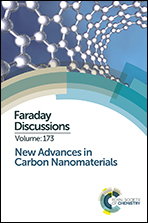Nitrogen segregation in nanocarbons
Abstract
We explore the behaviour of nitrogen doping in carbon nanomaterials, notably graphene, nanotubes, and carbon thin films. This is initially via a brief review of the literature, followed by a series of atomistic density functional calculations. We show that at low concentrations, substitutional nitrogen doping in the sp2-C graphenic basal plane is favoured, however once the nitrogen concentration reaches a critical threshold there is a transition towards the formation of the more thermodynamically-favoured nitrogen terminated ‘zigzag’ type edges. These can occur either via formation of finite patches (polycyclic aromatic azacarbons), strips of sp2 carbon with zigzag nitrogen edges, or internal nitrogen-terminated hole edges within graphenic planes. This transition to edge formation is especially favoured when the nitrogen can be partially functionalised with, e.g. hydrogen. By comparison with available literature results, notably from electron energy loss spectroscopy and X-ray spectroscopy, the current results suggest that much of the nitrogen believed to be incorporated into carbon nanoobjects is instead likely to be present terminating the edges of carbonaceous impurities attached to nanoobject's surface. By comparison to nitrogen-doped tetrahedrally amorphous carbon, we suggest that this transition at around 10–20% nitrogen concentration and above towards sp2 coordination via internal nitrogen-terminated edge formation may be a general property of nitrogen-doped carbon materials.
- This article is part of the themed collection: New Advances in Carbon Nanomaterials

 Please wait while we load your content...
Please wait while we load your content...